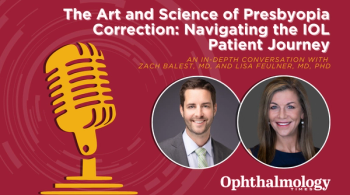
Blue-blocking IOLs may not be the panacea expected
Lisbon, Portugal – Blue-blocking IOLs, which recently have been promoted as being vision protecting, may not be so. Martin Mainster, PhD, MD, of the University of Kansas Medical School, Kansas City, explained that the argument in favor of blue-blocking IOLs is theoretical at the European Society of Cataract and Refractive Surgeons.
Lisbon, Portugal – Blue-blocking IOLs, which recently have been promoted as being vision protecting, may not be so. Martin Mainster, PhD, MD, of the University of Kansas Medical School, Kansas City, explained that the argument in favor of blue-blocking IOLs is theoretical at the European Society of Cataract and Refractive Surgeons.
Dr. Mainster studied the effects of IOL filters on circadian photoentrainment, scotopic sensitivity, and retinal photoprotection. To do this, he used spectral data for melanopsin absorbance, aphakic scotopic luminous efficiency and acute ultraviolet (UV) blue retinal phototoxicity, and transmittance spectra measured for available IOLs, data on the crystalline lens, and sunglasses transmittances, and transmittance spectra for hypothetical UV + violet blocking filters.
Compared with an IOL that blocks only UV light, a 53-year-old crystalline lens alters circadian photoentrainment, scotopic vision, and retinal photoprotection by –41%, –31%, and +61%, respectively. The crystalens (eyeonics) provides less 150% less photoprotection than a UV-blocking IOL, he reported; in comparison, a yellow-blocking IOL provided about 40% better UV blue photoprotection than a UV-blocking IOL, which is about the same as the UV + violet filter, he said.
However, the yellow-blocking IOL provides about 50% less photoprotection than sunglasses, according to Dr. Mainster. Interestingly, the yellow-blocking IOLs provide about 20% less blue-green phototoxicity protection than a 53-year-old crystalline lens, he added.
Dr. Mainster recommends blocking violet light because it is responsible for 67% of UV blue phototoxicity. It does not provide useful scotopic sensitivity and, he stated, that it should be blocked with IOL chromophores. In contrast, blue light causes only 14% of UV blue phototoxicity but provides 45% of scotopic vision.
“Blue light is much more important for scotopic than photopic vision. Scotopic sensitivity and dark adaptation decline with aging in everyone independent of lens yellowing, increasing the risk of falls, hospitalization, and death,” Dr. Mainster stressed. Blue light is also important to establish normal the wake/sleep cycle.
“I believe that the optimal IOL for night vision and circadian rhythm should transmit as much blue-light as possible. Blue-blocking IOLs give patients less retinal protection than sunglasses, less retinal protection than a 53-year-old crystalline lens that does not prevent age-related macular degeneration,” he concluded.
Newsletter
Don’t miss out—get Ophthalmology Times updates on the latest clinical advancements and expert interviews, straight to your inbox.


















































.png)


